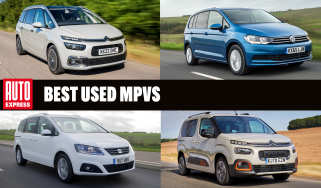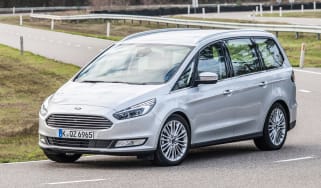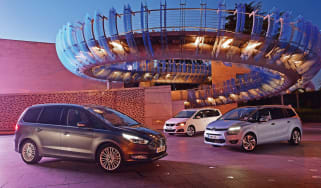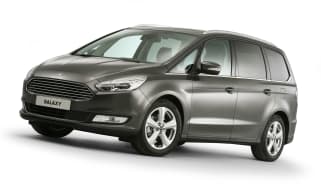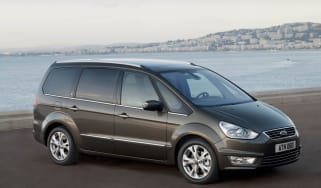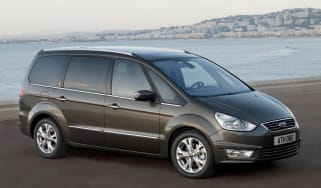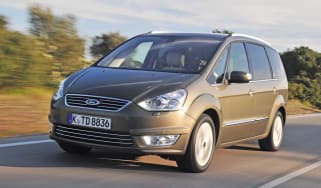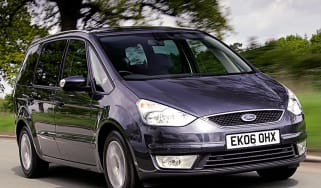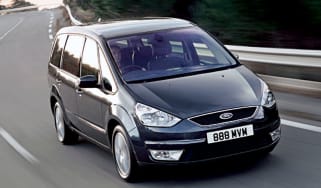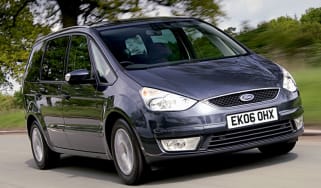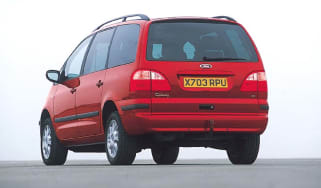Ford Galaxy (2015-2023) review
The Ford Galaxy offers acres of space for seven, and loads of tech on top models

This is a review of the 2015-2023 Ford Galaxy. If you are interested in information about a used Ford Galaxy please follow the links provided.
The Ford Galaxy is the largest MPV in the range, so it’s also the most spacious. It's a seven-seater, and the back two seats fold electrically into the floor, while the central row of seats drops down at the press of a button, so it’s extremely practical.
The Galaxy is reasonable to drive, but it has traded a little of the previous model’s handling for greater comfort and refinement, although it’s now one of the best in the large MPV class for refinement and luxury.
There’s a good range of 2.0 TDCi diesel engines available with four different power outputs, and a 1.5 EcoBoost petrol engine, while four-wheel-drive is available, so there's should be a Galaxy to suit your needs and budget if you're looking for one. The only real downside are the Galaxy's associations with the private hire industry, as well as the fact an SUV is a more desirable package for buyers, so residual values take a hammering. Get past that, and the Galaxy is a spacious and luxurious way to carry seven in comfort.
Used - available now

2023 Nissan
Juke
52,656 milesAutomaticPetrol1.6L
Cash £14,697
2025 Audi
A4 Avant
45,352 milesAutomaticPetrol2.0L
Cash £23,176
2022 Peugeot
2008
4,408 milesAutomaticPetrol1.2L
Cash £18,697
2022 Toyota
Yaris Hybrid
19,935 milesAutomaticPetrol1.5L
Cash £18,697The Ford Galaxy sits at the top of the range of MPVs for sale in Ford dealers today, both in terms of dimensions and luxury. The interior is home to seven seats, all of which have enough space for adults - yes, even the rearmost row - while the sliding and folding back seats allow you to adjust the cabin layout to suit your needs.
Ford is one of the few car makers that still offers people carriers, as the majority of firms now sell seven-seat SUVs instead. However, if ultimate space is your requirement, the Galaxy is still one of the roomiest family cars that you can buy. MPV rivals include Ford's own S-MAX, which shares its Ford Mondeo-sourced running gear with the Galaxy and is just a little bit smaller. Then there's the seven-seat Citroen Grand C4 SpaceTourer and Renault Grand Scenic, while the SEAT Alhambra and VW Sharan are getting a bit old, but come with handy sliding doors that make them worth considering.
Seven-seat SUVs are on the rise, but these are only really suitable as an alternative to the Galaxy if you only use the rearmost seats on occasion. If this suits you, then the Skoda Kodiaq, Peugeot 5008, Land Rover Discovery Sport, SEAT Tarraco, Honda CR-V and Nissan X-Trail are all available.
Another alternative is the van-based MPV, and again Ford offers something from within its own ranks that's suitable. The Ford Tourneo Custom, and even the Transit Double Cab In-Van, offer even more space than the Galaxy, but in a more functional package. Elsewhere, there are the Citroen SpaceTourer, Peugeot Traveller and Toyota Proace Verso which all share tech, the VW Caravelle, Renault Trafic Passenger and that other staple of the private hire fraternity, the Mercedes V-Class.
Prices for the Ford Galaxy start from about £30,000, rising to around £42,000 for the most expensive versions. Ford offers Zetec, Titanium and Titanium X trims to private buyers, and we'd recommend going for one of the higher specs to make the most of the Galaxy experience. If you're looking to buy an ex-private hire Galaxy, then it's worth noting that it will likely come in a tailor-made specification, and will miss some standard kit when compared to these trims.
There's a 1.5 EcoBoost petrol available, but the Galaxy's size and weight means it needs to work hard, with the payoff being poor fuel economy. You'll be better off with the 2.0 TDCi diesel, which comes in 120, 150, 190 and 240 outputs. Either the 150 or 190 versions offer the best balance of performance and economy, while manual or auto gearboxes and four-wheel drive are available with both.
Overall, the Galaxy is still a great choice if you want a plush seven-seat family car, although it does have relatively high running costs, while depreciation is a concern for private buyers.
Engines, performance and drive
Ford has a reputation for building cars that are fun to drive, and the previous generation Galaxy handled well, given that it was such a large MPV. However, the brand’s most recent large car platform (the same architecture that underpins the Ford Mondeo and S-MAX) is geared towards comfort rather than fun.
In the S-MAX, the new platform delivers a softer and more comfortable ride, and the Mondeo was a disappointment in comparison. Unfortunately, the Galaxy’s extra weight and size mean the driving experience is more like the Mondeo than the S-MAX.
Take it easy, however, and the Galaxy is nicely comfortable. The steering has a reasonable amount of weight (arguably not enough, but nobody buys an MPV based on this need), while stability and grip are superb, especially if you go for a four-wheel drive version. You can feel the body tipping from side to side in corners and the soft suspension is easily unsettled by any bumps, but that’s only when you’re really pushing on, which is pretty rare for MPV drivers.
The Galaxy now cruises along in near silence at town speeds and is remarkably hushed on the motorway. In fact we'd go as far as saying that the Galaxy is within touching distance of the most expensive luxury cars in terms of refinement, which is no mean feat. The suspension works well on smooth surfaces – it’s just firm enough to contain the Galaxy’s mass but not so hard that you can feel any small imperfections in the road.
The Ford S-MAX is still the go-to Ford MPV if you like to drive briskly, even though neither car is as sharp to drive as their predecessors. Fortunately, the Galaxy is still infused with enough of Ford’s handling expertise.
A six-speed manual gearbox is standard but pay about £1,550 extra for the Powershift automatic gearbox and the Galaxy becomes even smoother.
Engine
Two turbocharged EcoBoost petrol engines were available: a 158bhp 1.5 and 237bhp 2.0 petrol, but these have both been replaced in recent years by a 1.5 EcoBoost 165PS. It manages 0-62mph in 10 seconds, although this will give fuel economy a pounding. It only comes with a six-speed manual gearbox and front-wheel drive.
The diesels will take the overwhelming majority of sales. The 148bhp 2.0 TDCi 150 will be the best seller – it takes 10.9 seconds to reach 0-62mph and has plenty of acceleration in the mid-range. A lower powered 119bhp version is also available but it doesn’t offer any economy or emissions benefits and is a lot slower from 0-62mph, at 13.6 seconds, so it’s really just a cheaper option.
If you can stretch to the 187bhp 2.0 TDCi 190, the extra pulling power is worth it, especially when you’ve got a fully loaded car. The 237bhp variant of the 2.0 TDCi is the most powerful model in the range and is really quick for an MPV – it’s good for 0-62mph in 8.9 seconds – and offers heaps of mid-range punch.
Every version of the TDCi engine revs freely and there’s hardly any clatter that you might typically associate with a diesel, so it complements the Galaxy’s refined nature. Both the 150 and 190 engines get a six-speed manual gearbox as standard, with the option of an auto box available - this is standard with the 240 motor. Four-wheel drive is available with the 150 manual, while the 190 can be had with 4WD with the auto box and in Titanium X trim only.
MPG, CO2 and Running Costs
For a car with such a gargantuan interior, fuel economy and CO2 emissions figures for the Ford Galaxy are reasonable, although they still can’t match the Citroen Grand C4 SpaceTourer's class-leading figures, especially now that the Glaxy has been tested under the new WLTP test procedure. It's worth noting that while the official figures for the Galaxy are poorer than before, they will be more readily achievable in real-world driving.
The 119bhp 2.0 TDCi Galaxy has a manual gearbox as standard and has quoted economy of 52.3mpg and emissions of 135g/km. However, that's the same MPG figure quoted for the TDCi 150 motor, while emissions are slightly lower, at 134g/km. That figure is the same whether you choose Zetec or Titanium trims.
Add the auto gearbox, and economy drops to 49.6mpg and emissions rise to 140g/km, while the 4WD manual model manages 48.7mpg and 155g/km.
Again, the TDCi 190 with manual box has the same 52.3mpg and 134g/km figures as the 150 unit, while adding the auto sees figures of 47.9mpg and 137g/km quoted. The auto model has the option of 4WD, which returns figures of 44.8mpg and 159g/km. The most powerful TDCi 240 has a fuel economy figure of 48.7mpg, while emissions are 158g/km.
The 1.5 EcoBoost petrol engine is only really worth considering if you cover relatively few miles. It has quoted economy of 38.2mpg and emissions of 168g/km. If you use the Galaxy for regular trips fully loaded, then you're unlikely to get anywhere near the quoted MPG in regular driving.
Choose one of the highest spec Galaxy models, and you're looking at a list price in excess of £40,000, which means buyers will be paying the premium car road tax surcharge for the first five years of paying it.
Insurance groups
Insurance groups start at 17 for the entry-level 119bhp TDCi diesel and are either 20 or 21 for the 148bhp version depending on the trim level. The 187bhp diesels are in group 24 and the top-end version is in group 28. The Ecoboost petrols are in group 19 and 20, depending on which trim you choose.
The Citroen Grand C4 SpaceTourer is cheaper to insure, as groups start at 13 and top out at 25, comparable to the Volkswagen Sharan (which spans groups 15 to 23).
Depreciation
Ford’s residual values tend to be rather middle of the road when compared to rivals such as Volkswagen, which generally has very strong resale values. However, go for a good mid-level diesel model and the Galaxy is likely to hold onto its money comparably well. It’s also probably a safer bet than the rival Grand C4 SpaceTourer in this regard, as Citroens tend to depreciate quite heavily. Either way, a seven-seat SUV will have better residuals.
To get an accurate valuation on a specific model check out our free car valuation tool...
Interior, design and technology
When a car’s job is to cram in seven seats and maximise interior space at all costs, something has to give.
In the case of large MPVs, a boxy silhouette is pretty much a given, and the Galaxy is no different. However, Ford has done a great job of giving it an upmarket look.
Up front, the chrome grille has been sharpened and stripped of its Ford badge, which now sits on the edge of the bonnet. Mid-level Titanium models come with LED daytime running lights, while silver roof rails, extra silver window trim and tinted rear glass add to the upmarket look. The standard 17-inch wheels appear small, but Ford offers 18-inch alloy wheels as an option on Titanium models.
At the rear, the large tail-lights have a black outline and they merge with the rear window, which also forms the upper edge of the number plate recess. Overall, the Galaxy looks upmarket, although the single standard colour is a rather drab dark blue – white paint costs around £250, metallic finishes are about £550 and special ruby red paint is about £800.
The interior is not only made from better quality materials than its predecessor, but looks bang up to date. A chunky brushed aluminium trim and a host of smart geometric shapes – such as the air vents – give the interior a fresh, upmarket feel, while the optional full-length panoramic glass roof floods the interior with light and makes it feel twice as big again. It's so good that it's the same dashbard layout that's used in the S-MAX, while anybody driving a Ford Edge SUV or even a Mondeo will be familiar with the layout, too.
Sat-nav, stero and infotainment
The Galaxy comes with Ford’s Sync 3, an eight-inch high-resolution central touch screen system with voice control, as standard. This includes a DAB radio, aux and USB sockets, Bluetooth, an SD card slot and eight speakers. The touchscreen system means there aren’t too many buttons all over the dash, so the display is cleaner.
Mid-level Titanium models add Ford’s sat-nav system, while an optional digital display that fits snugly across the instrument cluster and into the dials is a useful addition, and can be fully controlled by the multifunction steering wheel.
Practicality, comfort and boot space
With its higher price tag, blunter handling and boxier styling, practicality is the only real reason customers will choose the Galaxy over the marginally smaller Ford S-MAX – even though both are seven-seaters. Luckily, the Galaxy delivers big time with an enormous boot, an interior littered with clever cubby holes and a hugely versatile seating layout.
Other handy features include cupholders for the third row, a three-point plug in the second row and a deep storage bin under the front armrest. You sit high, with a big windscreen and a good view of the road, while standard front and rear parking sensors make low-speed manoeuvring that bit easier.
Dimensions and size
The Galaxy is 4,848mm long, 1,916mm wide and 1,747mm tall, so it’s a big car. It’s very similar in proportion to rival MPVs such as the Volkswagen Sharan (4,854mm long, 1,904mm wide and 1,720mm tall) though it is a bit bigger than the Citroen Grand C4 SpaceTourer, which is 4,597mm long, 1,826mm wide and 1,625mm tall.
Leg room, head room & passenger space
The Galaxy has one of the most spacious and practical interiors of any MPV on sale. Whereas the smaller Ford S-MAX’s rearmost seats are really only for children, the Galaxy has just about enough space for two adults back there. The second row slides back and forth individually, too, if you need more legroom.
The seating system itself is simple to use. Folding all the seats flat couldn’t be easier – the third row folds down and back up electrically via a button mounted in the boot, while the second row (made up of three individual seats) flops forward by pressing another series of buttons in the boot, although you have to lift them up again manually. In addition, each of the individual middle row seats has Isofix child seat mounts.
Boot space
A powered tailgate is available as an option – a good idea given the sheer size of the door – and it opens to reveal an enormous boot. There’s 300 litres with all seven seats in place, 1,301 litres with the third row folded down and 2,339 litres with just the front two seats in place – that’s compared to 285/965/2,020 litres respectively in the S-MAX.
Towing
The Ford Galaxy is par for the course when it comes to towing. The maximum braked towing capacity is split up as follows: petrol-engined models can handle 1,800kg and diesels stretch to 2,000kg.
Reliability and Safety
The Galaxy received the full five stars when it was crash-tested by Euro NCAP in 2015. There were good scores in the individual categories: 87% for both adult and child occupants, 79% for pedestrian impacts and 71% for safety assistance.
As well as the usual host of air bags, tyre pressure monitors and Isofix mounting points on all three second row seats, the Galaxy has an intelligent speed limiter that can scan traffic signs and ensure you never break the speed limit. There’s also adaptive cruise control and an active lane keep assist function available as optional extras.
The auto-braking function can now detect pedestrians as well as other cars, while adaptive LED headlights adjust themselves automatically to avoid dazzling oncoming traffic. From our experience running a Ford S-MAX with this set-up, they're one of the best and most effective adaptive headlight systems we've tried.
In terms of reliability, much of the electronic and mechanical technology has been proved in the Mondeo, Focus and S-MAX already, and no significant problems have been reported. The higher-quality interior materials also feel built to last – even the cheaper plastics lower down on the dash have a reassuringly robust feel.
The current Galaxy sells in too few numbers to appear in our Driver Power customer satisfaction survey, but Ford itself has consistently finished in the lower half of the manufacturer table over the years. That isn’t great when you consider so many Fords are sold in the UK and it has the largest franchise network of any manufacturer in the UK. Build quality and reliability have seen some of the poorer individual results in the past, but the Galaxy may improve matters.
Warranty
Ford’s warranty is a standard three-year/60,000-mile package. While that’s the same as mainstream manufacturers such as Vauxhall, Volkswagen and Peugeot, it isn’t difficult to find a manufacturer selling a seven-seat MPV with a better warranty. Kia and Toyota are two of the best examples, as they both have seven-seater MPVs in their stables and offer cover spanning seven years/100,000 miles and five years/100,000 miles respectively.
Servicing
Ford recommends a main service every 12,500 miles for petrol-engined versions of the Galaxy and every 18,000 miles for diesel models. The firm offers a monthly payment service plan known as Service Assure, although the exact cost of this is based on individual circumstances.

